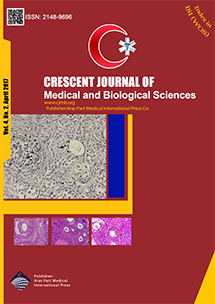| Original Article | |
| Comparison of Azithromycin and Pyrimethamine/Sulfadiazine Treatment in Ocular Toxoplasmosis in North West of Iran | |
| Leila Alizadeh Ghavidel, Amir Eftekhari Milani, Masood Bagheri | |
| Department of Ophthalmology, Nikookakari Eye Center, Tabriz University of Medical Sciences, Tabriz, Iran | |
|
CJMB 2017; 4: 080-084 Viewed : 4579 times Downloaded : 4623 times. Keywords : Azithromycin, Toxoplasmosis, Uveitis, Chorioretinitis |
|
| Full Text(PDF) | Related Articles | |
| Abstract | |
Objective: Ocular toxoplasmosis (OT), characterized by necrotizing retinochoroiditis, scar formation and decreased vision, is recognized as the most prevalent cause of posterior uveitis in Iran. Although pyrimethamine/sulfadiazine combination remains the standard treatment particularly for patients with sight-threatening lesions, intolerance, inaccessibility and adverse drug reactions to this regimen have imposed us to seek for alternative treatments. Materials and Methods: In this prospective randomized control clinical trial study, 72 patients with active, non-vision threatening toxoplasmic chorioretinitis were randomly divided into 2 treatment regimen: 36 patients treated with standard protocol with pyrimethamine/sulfadiazine, and 36 patients received azithromycin for 6 weeks. All patients were followed up for 24 months. The clinical outcomes measured before and after intervention were, time to disease inactivity (lesion borders sharpening and scarring), changes in the size of retinochoroidal lesion, rate of recurrence, adverse drug reactions and visual acuity (VA). Results: No significant difference was noted between the 2 groups regarding age, gender, and VA before treatment. Significant improvement was noted in VA for each group during treatment. VA increased by 0.39 logMAR units in group 1 (P = 0.00) and 0.35 logMAR units in group 2 (P = 0.00). There was no statistically significant difference between the 2 groups concerning visual improvement (P = 0.33) and reduction in retinal lesion size and activity. There were totally 22 cases who experienced recurrences during the follow up period (4 [11.1%] patients of control group and 18 [50%] of intervention group [P = 0.00]), indicating significant lower recurrence in control group. Treatment tolerance was significantly better for the azithromycin group due to lower adverse drug reactions (P = 0.00). Conclusion: Azithromycin at a dose of 250 mg/d was shown to be effective for the treatment of active, non-vision threatening toxoplasmic retinochoroiditis similar to classic treatment with Pyrimethamine/Sulfadiazine regimen. However, recurrences and adverse drug reactions seem to differ significantly which notes the need for further studies and also vigilant selection of treatment protocols. |
Cite By, Google Scholar
PubMed
Online Submission System
 CJMB ENDNOTE ® Style
CJMB ENDNOTE ® Style
 Tutorials
Tutorials
 Publication Charge
Medical and Biological Research Center
About Journal
Publication Charge
Medical and Biological Research Center
About Journal
Aras Part Medical International Press Editor-in-Chief
Arash Khaki
Deputy Editor
Zafer Akan


















